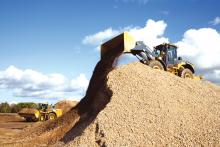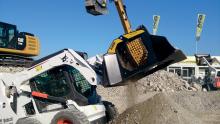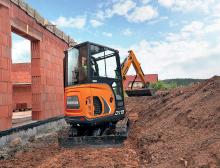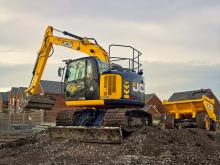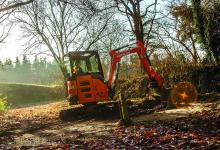Versatility remains the key for the utility equipment sector. The range of duties that compact machines can be used for continues to grow.
Versatility remains the key for the utility equipment sector
The range of duties that compact machines can be used for continues to grow. The rental sector is a prime purchaser of compact utility machines that are used in many segments of the construction market. Versatility is crucial and utility machines are expected to carry out numerous duties, with quick-hitch attachments speeding changeovers from one tool to another.The array of utility machines is diverse and includes units such as skid steer loaders, tracked loaders, telehandlers, small wheeled loaders, backhoe loaders, wheeled excavators and mini excavators. These are used in a huge array of construction-related duties, with such machines used widely in the highway sector for maintenance as well as for new construction. There are scarcely any highway construction jobs that do not feature a series of rented utility machines being used for an array of tasks.
Fuel for thought
Although fuel prices may have fallen once more, the recent hike in fuel costs have sharpened the view that economy is an important factor for off-highway machines. At the same time, ever tougher restrictions on exhaust emissions are prompting manufacturers to develop radical solutions and this is particularly important for the utility equipment sector, where machines often operate in space restricted environments. Several manufacturers have now unveiled hybrid prototypes, powered by a combination of diesel and electric power and featuring batteries. French firm Mecalac-Ahlmann has built a prototype Hybrid 12MTX multi-purpose machine, which features a dual drive system. This machine won a Gold Innovation award from theLoadlifting
Telehandlers and compact wheeled loaders are used to carry out a wide range of handling tasks on site, with strong pressure to release new models. Spanish manufacturerIn some European markets such as the UK and Ireland, telehandlers have been strong sellers and this has meant that neither country has historically been seen as a volume market for compact loaders. However, change may be coming as plant owners in the UK and Ireland begin appreciating the robust nature of the small wheeled loader. While telehandlers are often fitted with buckets, they are not as suitable as compact loaders for handling as telehandler booms are not designed for pushing into stockpiled materials. Northamptonshire aggregates supplier Bagforce is one UK firm that has made the change, replacing an old telehandler with a
Moving up to the top of the compact loader sector,
Reduced tailswing
The development of short radius versions of mini, midi and larger excavators has allowed the use of equipment in even more restricted sites. These are particularly useful for highway jobs as the units can be operated on maintenance and repair tasks alongside life traffic lanes.A wide array of manufacturers now offer machines, with new models coming regularly to market. Slotting in between
The machine is powered by a 96kW
Tracks replace wheels?
Several manufacturers are bolstering their skid steer loader ranges with tracked loaders, now that customers are beginning to appreciate that added stability of these units on difficult sites. The development curve has been quick and many new models are coming to market.Caterpillar is now offering customers greater choice with its latest improved machines for the utility equipment sector. Three new compact loaders, the 279C, 289C and 299C, are available and these feature durable and strong undercarriages that can cope with poor running conditions. Steel embedded and all-steel undercarriages are available and all the models are said to offer high traction on site. A new suspension type undercarriage has been developed by Caterpillar that features four independent torsion axles that is said to offer good ride characteristics even on rough ground. These machines offer high flotation and low ground pressure capabilities as well as good traction and long track service life. Two speed drive systems allow high travel speeds as well as high precision working. Both standard and high flow hydraulic versions of these machines are available. The High flow XPS variants suit the use of hydraulic attachments such as hydraulic breakers or planers. A mechanical quick coupler system is fitted that allows the operator to switch from one attachment to another.
Imer's IHI-built CL35 rubber-tracked skid steer loader is a compact machine that is powered by a Tier 3/Stage IIIA emissions compliant Yanmar engine, developing 49kW. The two-speed hydrostatic transmission offers 6.7kph and 10kph speed ranges for the 3.5tonne machine, which has an operating load of 780kg. The machine features an economy setting which can be used to provide fuel savings. Bucket capacity is 0.36m3 and the machine runs on 320mm wide tracks as standard, though 400mm wide tracks are optional.
Wheeled excavators
The integration ofMoving up the size range, New Holland's improved wheeled excavators offer increased performance. Replacing the current MH series, the new WE models are aimed at the 14, 15 and 21tonne wheeled excavator classes and benefit from upgraded hydraulics, electronics, service access and ergonomics. The large, high visibility cabs have new control systems that make these machines easier and more comfortable to operate. Customers can select from a range of boom and dipper as well as stabiliser and blade options to suit requirements.
Quick hitches
Caterpillar Work Tools is introducing the Fusion wheel loader quick coupler, which pulls the coupler and work tool closer to the wheel loader. The patented design moves the centre of gravity closer to the machine, allowing the loader to pick up and use a wide range of work tools. The system is designed for wheel loader models ranging from the 938H-972H, including the IT38 and IT62. The system also gives the operator good sight lines to the work tool, load and target location. Eliminating play increases reliability by reducing wear on the coupler/tool bearing surfaces.Klac Industrie is building on its experience with its quick-hitch systems aimed at machines in the 1-9tonne market to introduce new and much larger versions. Three units have been developed for machines in the 9-23tonne range and these are said to be compact, safe and efficient according to the firm. The design features a mechanical locking mechanism and in the event of a power failure by the carrier will retain the attachment, while an alarm will sound in the cab in the event of an attachment not being locked into place properly. Meanwhile the slim-line hitch design also ensures that the attachment is kept close to the boom of the carrier. The hitch is also said to be able to cope with the particularly high loads exerted by certain attachments such as breakers or compaction plates.
Austrian firm Martin is offering an improved multi-coupling system and its patented MMK unit is able to connect several hydraulic lines at once. There is no pressure on the housing and this is said to make the MMK unit almost wear-free. Safe in operation, the couplings are also protected against dirt ingress and this minimises wear and tear on the attachment while a quick visual inspection by the operator is sufficient to ensure the unit has located properly.
New options for the

